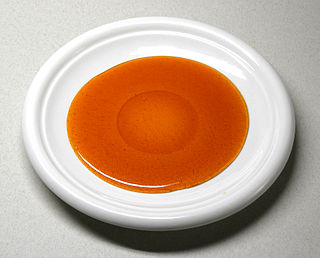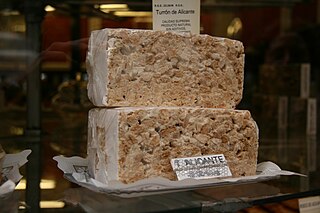
Confectionery is the art of making confections, which are food items that are rich in sugar and carbohydrates. Exact definitions are difficult. In general, however, confectionery is divided into two broad and somewhat overlapping categories: bakers' confections and sugar confections. The occupation of confectioner encompasses the categories of cooking performed by both the French patissier and the confiseur.

Caramel is an orange-brown confectionery product made by heating a range of sugars. It can be used as a flavoring in puddings and desserts, as a filling in bonbons or candy bars, or as a topping for ice cream and custard.

Halva is a type of confectionery originating from Persia and widely spread throughout the Middle East as well as South Asia. The name is used for a broad variety of recipes, generally a thick paste made from flour, butter, liquid oil, saffron, rosewater, milk, cocoa powder, and sweetened with sugar.

Turrón, torró and torrone is a southwest European nougat confection, typically made of honey, sugar, and egg white, with toasted almonds or other nuts, and usually shaped either into a rectangular tablet or a round cake. Turrón is usually eaten as a dessert food around Christmas in Spain and Italy. It's also known in Portugal and the countries of Latin America.

Daniël Hartman Craven was a South African rugby union player (1931–1938), national coach, national and international rugby administrator, academic, and author. Popularly known as Danie, Doc, or Mr Rugby, Craven's appointment from 1949 to 1956 as coach of the Springboks signalled "one of the most successful spells in South African rugby history" during which the national team won 74% of their matches. While as a player Craven is mostly remembered as one of rugby's greatest dive-passing scrumhalves ever, he had also on occasion been selected to play for the Springboks as a centre, fly-half, No.8, and full-back. As the longest-serving President of the South African Rugby Board (1956–93) and chairman of the International Rugby Board, Craven became one of the best-known and most controversial rugby administrators. In 1969, Craven sparked outrage among anti-apartheid activists when he allegedly said, "There will be a black springbok over my dead body". Craven denied saying this and in his later career promoted coloured training facilities.

South African cuisine reflects the diverse range of culinary traditions embodied by the various communities that inhabit the country. Among the indigenous peoples of South Africa, the Khoisan foraged over 300 species of edible food plants, such as the rooibos shrub legume, whose culinary value continues to exert a salient influence on South African cuisine. Subsequent encounters with Bantu pastoralists facilitated the emergence of cultivated crops and domestic cattle, which supplemented traditional Khoisan techniques of meat preservation. In addition, Bantu-speaking communities forged an extensive repertoire of culinary ingredients and dishes, many of which are still consumed today in traditional settlements and urban entrepôts alike.

Caramel corn or caramel popcorn is a confection made of popcorn coated with a sugar or molasses based caramel candy shell that is normally less than 1mm thick. Typically a sugar solution or syrup is made and heated until it browns and becomes thick, producing a caramelized candy syrup. This hot candy is then mixed with popped popcorn, and allowed to cool. Sometimes, a candy thermometer is used, as making caramel is time-consuming and requires skill to make well without burning the sugar. The process creates a sweet flavored, crunchy snack food or treat. Some varieties, after coating with the candy syrup, are baked in an oven to crisp the mixture. Mixes of caramel corn sometimes contain nuts, such as peanuts, pecans, almonds, or cashews.

Christian Frederik Louis Leipoldt, usually referred to as C. Louis Leipoldt, was a South African poet, dramatist, medical doctor, reporter and food expert. Together with Jan F. E. Celliers and J. D. du Toit, he was one of the leading figures in the poetry of the Second Afrikaans Movement. Apart from poetry, Leipoldt wrote novels, plays, stories, children's books, cookbooks and a travel diary. He is numbered amongst the greatest of the Afrikaner poets and was described by D. J. Opperman, himself a noted South African poet, as "our most versatile artist".

Brittle is a type of confection consisting of flat broken pieces of hard sugar candy embedded with nuts such as pecans, almonds, or peanuts, and which are usually less than 1 cm thick.
Johannes du Plessis Scholtz was a South African philologist, art historian, and art collector.
Dr. Daniel Hugo is a poet, translator, compiler and editor. He worked a specialist announcer / producer for Radiosondergrense, the national Afrikaans radio service, and was also responsible for the literary programmes "Leeskring" and "Vers en Klank". He is an edit at the publishing house Protea Boekhuis.

Bobotie is a South African dish consisting of spiced minced meat baked with an egg-based topping.

Andries Gerhardus Visser was a well-known early Afrikaans poet. He was popularly known as the "Singer of the Suikerbosrand".

Hoërskool Voortrekker is a public Afrikaans medium co-educational high school situated in the municipality of Boksburg in the city of Ekurhuleni in the Gauteng province of South Africa. The academic school was established in 1920.
Johannes Jacobus (Johan) Degenaar OIS was a South African philosopher, and Emertitus Professor at the Stellenbosch University, who is considered "one of the most respected and influential philosophers in South Africa."
Hester Henriette Grové(née Venter) was a South African writer of African origin. She was married to the literary critic A.P. Grové.
Marthinus Versfeld was a South African philosopher. From 1937 to 1972 he taught at the University of Cape Town. He was celebrated as researcher, enjoyed the recognition of the South African literary community and was known as an opponent of the Apartheid system. His work ranged from scholarly books to playful essays on issues like ethics, anthropology, the meaning of life.
S. V. Petersen (1914–1987) was an Afrikaans-language South African poet and author, educator and founding principal of the Athlone High School, Silvertown [Athlone]], Cape Town. He was the first person of colour whose poetry and prose were published in South Africa.
Johannes Petrus Spies was a Namibian author and popular storyteller. Alongside P.G. du Plessis he was the presenter of the popular television program Spies en Plessie – met permissie, and hosted personalities like Tolla van der Merwe, Koos Meyer, Danny Pretorius, Nico Nel and Pyp de Villiers.












